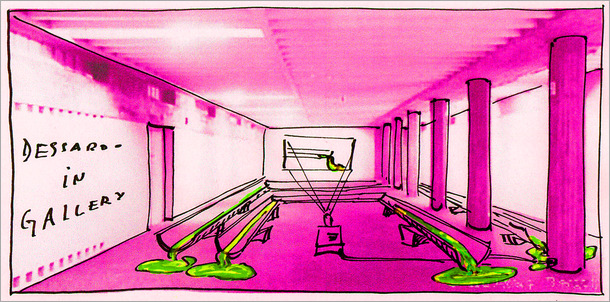
Dr. Isabella Kreim‘s request: can Dessardo make an aqueduct in the Kunstverein Gallery of Ingolstadt?
Mmm... Let's see.
Take PVC common gutters for the new aqueduct.
Look for water.
Need a source and an exit, a source is a tap out of the room, but there isn‘t any water exit at ground level. A starting point without an ending.
Imagine a round trip aqueduct, following the perimeter of the gallery space.
The end reaches the beginning.
The end and the start are at same level, water cannot flow naturally.
Need a pump to carry the water from the end to the beginning of the aqueduct.
And the pump creates a flow.
Flow is necessary for an aqueduct!
The pump may create strange water drops noises.
To allow the public to visit the gallery, the round trip should be "U" folded.
The aqueduct follows the gallery columns. It makes a small possible detour around the gallery‘s columns.
The aqueduct form adapts to the gallery local constraints.
Placement of the three screens in the perimeter space preserved from public passage.
The screens show the three previous aqueducts installed in forest in Belgium, in Korea, and in The Netherlands.
The aqueduct is filled with water.
Water indicates the real horizontal level of the place.
Some wood wedges are placed to avoid any water overflow.
Dessardo aqueduct n°4 has to be rather horizontal.
«wasserstand».
The wedges are small pillars that mark the distance between the specific site horizontalility and the ground of the gallery.
The layout of the wedges is specific to the gallery which is no longer considered as a white cube, but the base of the artwork.
Maybe «wasserstand» could be renamed «Ingolstadt wasserstand».
aqueduct n°4, 48° 45' 46.29" N, 11° 25'42.72" E, dessardo, 2007
Assistant: Simon Templer and thanks to Helmut Mahr for some of the photos.
52 x 25 x 0.2 m, PVC, water, screens, wood

































































